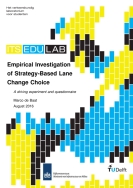In practice, microscopic traffic simulation models are often used for the analysis and management of transport systems. These models simulate the movement of individual vehicles by using a carfollowing model for the longitudinal behaviour of drivers and lane change model for their lateral behaviour. However, current lane change models cannot simulate all driving behaviour that is seen in reality. Recent research revealed that drivers apply four different lane change strategies when driving on motorways:
- Speed leading: Drivers settle for a speed and try to keep that speed. When they encounter a slower vehicle in front of them in the current lane they will change lanes so that they can maintain their speed.
- Speed leading with overtaking: This strategy is almost similar as the ’speed leading’ strategy. However, in this strategy drivers consider changing lanes when they encounter a slower predecessor as overtaking and will accelerate while doing so.
- Lane leading: Drivers choose a lane based on their perceived relative driving speed and will adapt their speed to the vehicles in that lane.
- Traffic leading: Drivers have no desired lane or speed but copy the speed of other drivers on the road, which could either be the faster or slower ones.
A model in which these four lane change models are incorporated cannot be used yet, since the lane change strategies need more quantification and the parameters require further calibration and validation. This study aims to reveal how many drivers apply each of the four lane change strategies, and what factors influence the distribution of drivers over these strategies. The research methodology to reach the objective includes a literature study, an interview-based field test and a video-based online questionnaire. In total 34 drivers took part in the interview-based field study, which was held in February 2016. The driving study consisted of three components: the test drive, a background information survey and an interview. First of all, participants had to drive in a camera-equipped car a predefined route that led over several motorways in the vicinity of Delft. Directly after the test-drive the participants were interviewed based on the video recordings of their trip. The aim of the interview was to reveal which lane change strategies a driver applies on the motorway, and their motives behind the application of the different lane change strategies. The video-based questionnaire was spread online via various channels and received in total 1258 valid responses from within the Netherlands. The questionnaire consisted of 14 traffic scenarios that were described by a short video of approximately 10 seconds, for which the respondents had to answer how they would behave at the end of the video clip in terms of their lane and speed choice. Several multiple choice answers were given, but respondents were also allowed to formulate their own answers.
The results show that most drivers, 90 to 95%, apply mainly one of the two speed leading strategies, meaning that they choose a speed and try to maintain that speed by changing lanes if necessary. About 5 to 10% of the drivers prefer to drive in a specific lane and adapt their speed to their predecessors. However, the results show that in some situations significant shares of drivers change strategy. When drivers have to take an exit within a limited distance many drivers tend to stick to the shoulder lane and adapt their speed, while others only use the centre and shoulder lane, and only a few still drive according to the speed leading strategies. Furthermore, although drivers in the Netherlands need to keep right as much as possible unless they are overtaking, significant shares of drivers do not keep right. Not keeping right can be seen as lane leading driving behaviour. Additionally, 15 to 20% of the respondents would overtake another driver via its right side, while this is forbidden in the Netherlands. Finally, about 83% of the drivers cooperate with a vehicle that wants to merge onto the main roadway, while the other 17% argues that the merging vehicle should adjust to them. Concluding, the results indicate that there are significant shares of drivers who choose a lane first and then choose a speed. Lane change models can be improved by incorporating the four lane change strategies.
